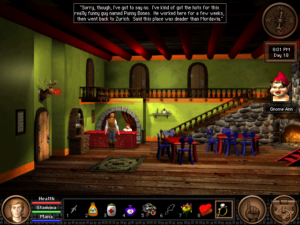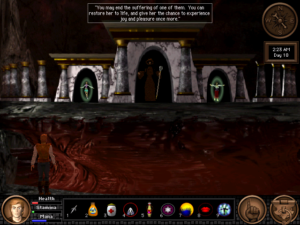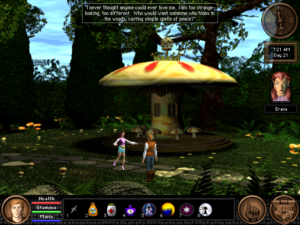QfG5: Courtship Mechanics
 I keep thinking of the courtship material in Quest for Glory V as a mini-Dating Sim, but any resemblance to actual dating sim games is almost certainly coincidental. The genre was pretty much unknown outside Japan in 1998 — heck, it’s almost unknown outside Japan today. The closest thing to a mainstream American version of the genre would probably be Leisure Suit Larry 1Notably, a Sierra game, like the QfG series and its progeny: “adult” adventure games where the primary goal is seduction. But there are major differences, and to my mind, the biggest difference is this: In the American version, the player encounters a series of women, and must (or at least can) have “successful encounters” with them all. In the Japanese version, there are also a number of available women, but the whole idea is to choose one, and, provided you’ve made the right decisions in your interactions with her throughout the game, to have her choose you as well. You might pursue multiple possible lovers over the course of the game, but in the end, you have to pair off with one and one only.
I keep thinking of the courtship material in Quest for Glory V as a mini-Dating Sim, but any resemblance to actual dating sim games is almost certainly coincidental. The genre was pretty much unknown outside Japan in 1998 — heck, it’s almost unknown outside Japan today. The closest thing to a mainstream American version of the genre would probably be Leisure Suit Larry 1Notably, a Sierra game, like the QfG series and its progeny: “adult” adventure games where the primary goal is seduction. But there are major differences, and to my mind, the biggest difference is this: In the American version, the player encounters a series of women, and must (or at least can) have “successful encounters” with them all. In the Japanese version, there are also a number of available women, but the whole idea is to choose one, and, provided you’ve made the right decisions in your interactions with her throughout the game, to have her choose you as well. You might pursue multiple possible lovers over the course of the game, but in the end, you have to pair off with one and one only.
So it’s interesting to me that the authors of QfG5 invented a simplified form of the Japanese model without any likely direct influence. There are several available female NPCs. There is a wedding ring, the “Ring of Hera”, a unique item 2Apparently there was a bug in the initial release that allowed the player to purchase multiple wedding rings. Since I patched before playing, I don’t know how badly this messes things up. that you can present to whoever you like as a proposal of marriage. Towards the end of the game, it’s possible that someone will even accept, depending on how you’ve treated her, and since this is definitely the final chapter of the story, the two of you presumably live happily ever after.
There seem to be three components to the proposee’s decision. First, you have to talk to her about a bunch of different things, or she’ll object that she hardly knows you. Every NPC’s conversation menu changes as the story goes on, so this is basically a limit on how early in the game you can propose. Secondly, you have to give her stuff. Not specific items, just a sufficient total value of acceptable items (you can tell when you’ve given enough from her reaction). This probably sounds degrading, as if you’re buying her affections, but the in-game dialogue makes it clear that the authors thought of it as confirming that you know the woman well enough to know what sort of thing she’d like. Everyone seems to appreciate flowers, but Nawar (a bellydancer at the bar) is fond of jewelry, while Elsa von Spielburg rejects such frippery in favor of combat-enhancing magic items. Thirdly, there seems to be some consideration of indirect behavior. The first time I tried proposing to Elsa, she told me that I had given her no reason to believe that I respect her fighting skills, which I take to mean that she wants a man who would go to cheer her on in the arena when she fought there, and possibly bet on her.
 I have managed to convince four women in the game to accept my proposals of marriage. (Not all in the same game, obviously.) I’ve mentioned two: Elsa and Nawar. The other two are the dead chicks. See, in the fifth Rite, you go to hell. There are two spirits there who you know from previous games, one Good Girl and one Bad Girl. The Good Girl is Erana, the half-faerie archmage who spent her life wandering the globe and planting enchanted gardens so that heroes would have a place to sleep outdoors without being et by wandering monsters, and who ultimately sacrificed her life to prevent QfG4‘s “Dark One” from awakening. The Bad Girl is Katrina, who began QfG4 as an apparent damsel in distress, became more like a woman of mystery, and finally turned out to be an obsessed vampire sorceress bent on awakening the Dark One from His eternal slumber. By the end, she was starting to find redemption through her love for the hero, but she got killed anyway, and it was all quite tragic. You can free one of these two from death, and there aren’t even any stupid rules about it like with Eurydice. But whichever you choose, the other is consigned to oblivion, which just doesn’t seem fair. If you’re really heartless, you can just leave them both there, but you cheat yourself out of some content that way. 3There’s actually some motivation to do this: as the price of raising the dead, your Stamina goes down 50%. But this isn’t as bad as it sounds. Stamina is probably the easiest stat to raise, thanks to the exercise equipment in the Adventurers’ Guild. Anyway, either one will marry you with minimal prompting.
I have managed to convince four women in the game to accept my proposals of marriage. (Not all in the same game, obviously.) I’ve mentioned two: Elsa and Nawar. The other two are the dead chicks. See, in the fifth Rite, you go to hell. There are two spirits there who you know from previous games, one Good Girl and one Bad Girl. The Good Girl is Erana, the half-faerie archmage who spent her life wandering the globe and planting enchanted gardens so that heroes would have a place to sleep outdoors without being et by wandering monsters, and who ultimately sacrificed her life to prevent QfG4‘s “Dark One” from awakening. The Bad Girl is Katrina, who began QfG4 as an apparent damsel in distress, became more like a woman of mystery, and finally turned out to be an obsessed vampire sorceress bent on awakening the Dark One from His eternal slumber. By the end, she was starting to find redemption through her love for the hero, but she got killed anyway, and it was all quite tragic. You can free one of these two from death, and there aren’t even any stupid rules about it like with Eurydice. But whichever you choose, the other is consigned to oblivion, which just doesn’t seem fair. If you’re really heartless, you can just leave them both there, but you cheat yourself out of some content that way. 3There’s actually some motivation to do this: as the price of raising the dead, your Stamina goes down 50%. But this isn’t as bad as it sounds. Stamina is probably the easiest stat to raise, thanks to the exercise equipment in the Adventurers’ Guild. Anyway, either one will marry you with minimal prompting.
There are a couple of other NPC women who may or may not be marriagable: the flirtatious but punning gnome who runs the inn, the overweight bartender who talks like Mae West. But then again, the authors might have intended the four potential wives that I know about to correspond to the four character classes: materialistic Nawar is the obvious match for the Thief, bellicose Elsa is the Fighter’s mate, Erana has been called “a paladin in all but name” within the game, and that leaves the goth in the tower for the Wizard. This is exactly the kind of fourfold symmetry that was originally supposed to be in the architecture of the series as a whole.
Just one thing: not all wives are equal. As with any difficult task, proposing marriage earns you points. And yes, even talking about this seems demeaning to the characters again. The game is giving me a choice of my alter-ego’s life-partner. Do I really want to base that decision on who has the highest point value? Yes. Yes, I do. I’m sorry. I want my full 1000 points no matter what it takes, and that puts limits on who I can marry. I do still get some choice: both of the dead chicks are worth 20 points. Elsa comes in third at 15 points, and Nawar — who, let’s face it, has no great appeal beyond the theoretical hotness of her profession — clocks in at 10. But I’ll still probably want to check out how it ends with every possible wife. And, for that matter, with no wife at all. This whole aspect of the game seems to be optional.
 Romantic elements in games are peculiar. I’ve spent so much of this post describing the courtship in this game in reductionistic terms because that’s the approach that the level of simulation invites: we know full well that this is a machine following simple rules and spitting out canned text. But for all that, I have to admit that I felt a little thrill when Erana said yes (the first yes I received), and that it wasn’t just the thrill of solving a difficult puzzle. The poignancy of Erana’s position helped: even as one of the most accomplished mages in the world, and one of the most compassionate, she felt herself such an outsider that the idea of being loved humbled and amazed her. All this emotional revelation was provoked by the game engine processing a couple of flowers and a box of chocolates. But even with such a crude emotional model, the game provides us with the emotive power of fiction, amplified by player involvement. This can work very effectively for fear as well.
Romantic elements in games are peculiar. I’ve spent so much of this post describing the courtship in this game in reductionistic terms because that’s the approach that the level of simulation invites: we know full well that this is a machine following simple rules and spitting out canned text. But for all that, I have to admit that I felt a little thrill when Erana said yes (the first yes I received), and that it wasn’t just the thrill of solving a difficult puzzle. The poignancy of Erana’s position helped: even as one of the most accomplished mages in the world, and one of the most compassionate, she felt herself such an outsider that the idea of being loved humbled and amazed her. All this emotional revelation was provoked by the game engine processing a couple of flowers and a box of chocolates. But even with such a crude emotional model, the game provides us with the emotive power of fiction, amplified by player involvement. This can work very effectively for fear as well.
| ↑1 | Notably, a Sierra game, like the QfG series |
|---|---|
| ↑2 | Apparently there was a bug in the initial release that allowed the player to purchase multiple wedding rings. Since I patched before playing, I don’t know how badly this messes things up. |
| ↑3 | There’s actually some motivation to do this: as the price of raising the dead, your Stamina goes down 50%. But this isn’t as bad as it sounds. Stamina is probably the easiest stat to raise, thanks to the exercise equipment in the Adventurers’ Guild. |
 Comments(3)
Comments(3)
I think Sid Meier’s Pirates had a similar system where you got more points for marrying the beautiful governor’s daughter. The graphics were such, in both the 80’s version and the recent version, that you could make a case for the average daughter being cuter than the beautiful daughter. So your choice was largely based the point value assigned to each.
In both the original and the remake, the ugly governor’s daughter is noticeably uglier than the others. Especially in my copy of the 80’s version, where a graphics glitch in the portrait caused her head to be below her torso.
Also: I affirm that a dating-sim section in an adventure/rpg game has its own piquancy. I liked the date section of FFVII. Caolan’s favorite part of the Medieval Total War game was the part where you marry foreign princesses.
Perhaps the lower points for Elsa & Nawar correspond to you have to do more to get them, getting more points beforehand.
I know this post is 15(!) years old now, but I just felt like saying a few things.
First, what Elsa wanted was to fight you. You need to enter an arena battle against Elsa in order to be able to wed her. Win or lose, it doesn’t matter. If you spamcast Zap (which can be done in the arena by dragging the spell onto your weapon of choice) you can humiliate her – she doesn’t mind.
As for marrying multiple wives, it can be done even in the newest patch: just marry Katrina, then Elsa or Nawar. Katrina doesn’t take the ring after a successful marriage, so you can use it again. Alternately, you can use qfg5patcher (which you should for its fixes, especially if you still have the boxed copy) and undo that particular update.
And 1000 points isn’t all the points, it’s just the cap. You can’t get every point event in one playthrough – Paladins have Marry Katrina, Fighters have Marry Erana, Thieves have both, plus resurrecting one or the other are mutually exclusive… and not even a Wizard can marry a corpse – so 1000 serves as the cap, not the total.